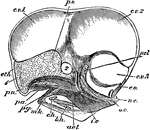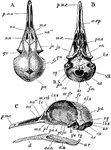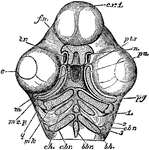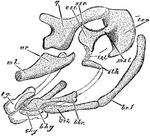Clipart tagged: ‘bird skull’

Bird Skull Disarticulation
"Disarticulation of bird's skull. Membrane bones shaded. B.Oc., basioccipital; E.Oc., exoccipital; S.Oc.,…

Chick Head
"Fig 66 - Head of a chick, second stage, after five days of incubation, section in profile; x6 diameters.…
Cormorant Skull
"Phalacrocorax bicristatus. Red-Faced Cormorant. Skull showing sto, occipital style or nuchal bone;…

Common Fowl Skull
"Schizognathous skull of common fowl, nat. size, from nature, by Dr. R.W. Shufeldt, U.S.A. Letters as…

The Skull Structure of an Ostrich
"Dromaeognathous skull of ostrich, nat. size specimen no. 16,629, U.S. Nat Museum, by Dr. R. W. Shufeldt,…

Rock Pigeon Skull
"Columba livia. Skull of young specimen. A, dorsal; B, ventral; C, left side. al. s, alisphenoid; au,…

The Skull of a Raven
"Aegithognathous skull of raven, Corvus corax, nat. size, from nature, by Dr. R. W. Shufeldt, U.S.A.…

Skull of a Bird
The skull of a bird. Labels: a, inferior aspect, the mandible being removed; b, lateral aspect; px,…

Skull of a Chick
"Fig 64 - Skull of chick, fifth day of incubation, x 9 diameters. Seen from above, the membranous roof…

Skull of a Chick Below
"Skull of a chick, but seen from below. cv1, anterior cerebral vesicle; e, eye; m, mouth; pts, pituitary…

The Skull of a Woodpecker
"Side view of a woodpecker's skull, showing the long slender basihyal (bh), bearing slight elements…

Bird Skull
"Schizognathous skull of common fowl. pmx, premaxilla; mxp, maxillopalatine; mx, maxilla; pl, palatine;…

House Martin Skull
"The post-oral arches of the house martin, at middle of period of incubation, lateral view, X14 diameters.…

Mallard Duck Skull
"Desmognathous skull of mallard duck, Anas boscas, nat. size, from nature, by Dr. R.W. Shufeldt, U.S.A.…

The Skull of a Tinamou
"Dromaeognathous skull of a tinamou (Tinamus robustus); copies by Shufeldt from Huxley. Letters as before;…

Top View of a Woodpecker Skull
"Top view of skull of Cloaptes, (flickers) showing thyrohyals running along the skull and into right…